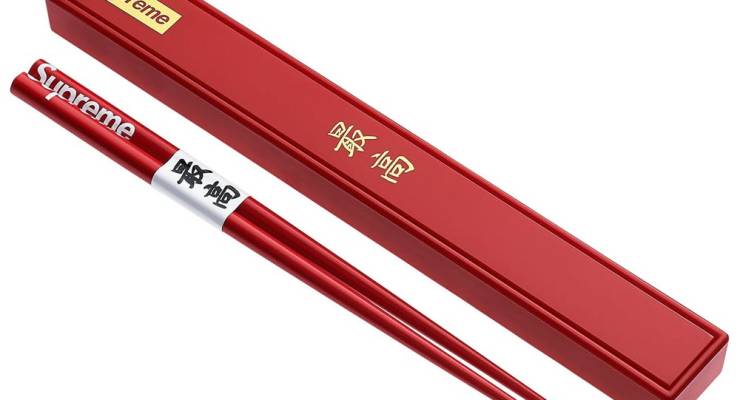
The skateboarding brand Supreme was founded in 1994 in New York, and has become something of a phenomenon. The popularity has reached such a crescendo that they can sell just about anything now. When Supreme released these chopsticks for $24 as part of their 2017 Fall/Winter Collection, they sold out online in 21 seconds.
That Supreme products sell in the first place, and then resell at inflated prices — they’re now selling for hundreds of dollars around the internet — is bad news for the market economy. It goes to show how ill-suited the human mind is to dealing with what prices really mean.
The concept here is not new: a company gets customers to pay crazy prices for luxury goods. But in this case, the mechanics of it are so visible it is a good opportunity to have a look at the big problem with prices. What Supreme does is limit the runs of each product. “We don’t want to get stuck with stuff nobody wants,” claims company founder and CEO James Jebbia.
That may have been true in the beginning. But the lines of people around the block when Supreme releases a new product suggest the company has discovered the margin-pumping benefits of artificial scarcity.
The chopsticks cost more now via the various resellers than when they were first released by Supreme, but even back then the value proposition was murky.
As one British YouTube reviewer says, “Why did I pay £20 for these when I can spend $1 pound on these normal ones?” [He then picks up some plain plastic chopsticks.] “And I’m not going to lie — I think these ones are better — these standard Chinese ones you can find anywhere.”
Nevertheless he goes on to conclude that the Supreme chopsticks are worth buying because they are “going to be a collectable.”
The theory
What prices are supposed to do — in theory — is encourage people to buy things that are plentiful, and discourage us from buying things that are scarce. When a cyclone hits Queensland and the price of bananas goes to $14 a kilo, I eat oranges. When bananas drop to $1.49 a kilo, I buy them by the bunch.
That’s the free market at its machine-like best. Matching supply with demand by way of prices. It’s a thing of beauty that maximises efficiency and reduces waste.
But prices have other, far more pernicious effects in the human brain. High-priced items send a message. We know our peers will notice items that are rare and unusual and expensive. And people love to be noticed. So they want what’s rare, even if that rarity is entirely manufactured.
Our minds mix up the signifier and the signified: does the specialness of the object make the price high, or does causation go the other way? You know what — it doesn’t matter. I’ll take it.
Bank on it
Supreme may make a small number of each product, to make them seem scare and elevate margins. But it counters this by having a wide range of products, which have scant connection to streetwear and skateboarding.
The chopsticks are one example of the brand whacking the logo on something. You can also buy a rug. A ballpoint pen. A Zippo lighter. A tube of tennis balls. Work gloves. A thermos. A toboggan.
It’s hard not to look at the pen reselling for $90 and think someone somewhere is laughing their arse off at their own customers. The alternative — that someone within Supreme thinks the hype is justified — is almost more horrible to contemplate.
Positional goods
We see this most clearly with positional goods. Goods that are scarce by definition — front row seats, for example, or penthouse living.
The best house on the best street, the fastest car, the world’s largest diamond — these are all things that are inherently, mathematically scarce. Knowing that is what makes them positional goods. And that’s why these things cost so much.
Looking at Supreme, it’s easy to laugh at the rich kids buying it. Considering the brand’s impact gets more complex when you imagine the kids on the bus looking at them and feeling envious, feeling like they’re missing out.
Those kids go home and count their money, refresh the resale websites, hoping to buy something — even a pair of chopsticks they’re smart enough to see are not especially functional — to get a bit of the magic to rub off on them. Then they feel inadequate when they can’t.
That’s the big problem with prices. The human brain doesn’t work like the economic models want it to. It often perversely wants what is scarce. And it feels bad when it can’t get it. The opposite of Supreme is inferior, least and littlest. Nobody wants to be that. That’s the weakness that Supreme is exploiting.








Wow! Where can I get them? They look great! Straight to the pool room they’d go!
Brand names, especially in fashion, have become more important than the actual product. Of course it can backfire when images appear of a a dishevelled, ice-crazed miscreant being arrested whilst sporting a Hugo Boss t-shirt. I can still picture convicted killer, Carl Williams, in a red sweater boasting Polo Jeans.
Short version – people are dumb. The only hope for humanity is that some are dumber than tuthers.
Sometimes brands have a place though, for example I buy Levi 501’s because I know my arse looks good in them. Perhaps Supreme is trading on the quality of its skate boards and people attribute quality by association.
Selling shit to idiots is Supremely simple.